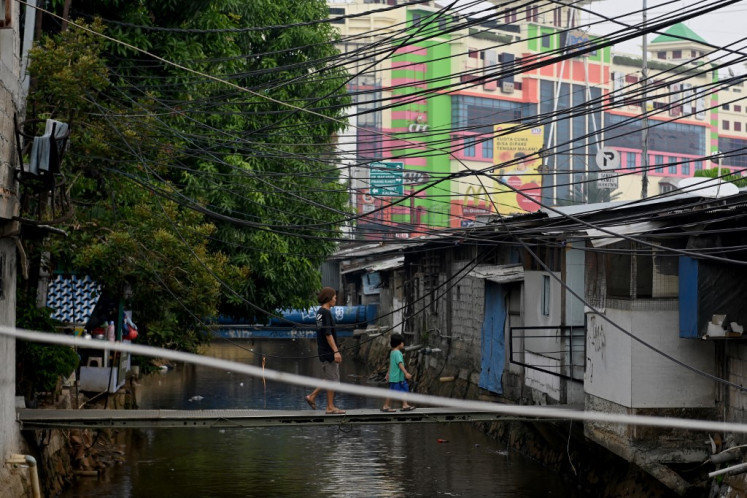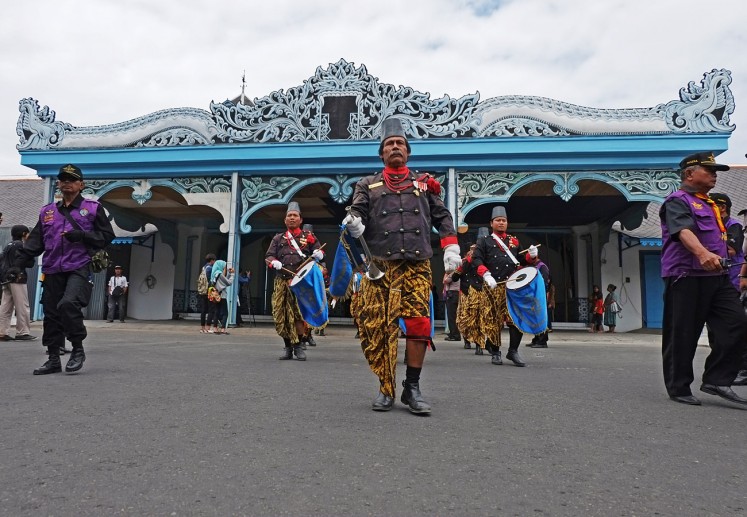Balinese, native Lampung determined to let bygones be bygones
Following rising religious intolerance in the past couple of years, an ethnic clash in South Lampung regency, Lampung, late last month, has put Indonesia’s much-boasted pride in tolerance and diversity to another round of tests
Change text size
Gift Premium Articles
to Anyone

F
ollowing rising religious intolerance in the past couple of years, an ethnic clash in South Lampung regency, Lampung, late last month, has put Indonesia’s much-boasted pride in tolerance and diversity to another round of tests. The Jakarta Post’s Hans Nicholas Jong recently traveled to the conflict zone to uncover the root causes of the incident.
Balinuraga and Sidoreno villages, inhabited by Balinese Hindus, are the epitome of success. The transmigration program has turned a backwater into a prosperous agricultural center.
The villages, once opulent in typical Balinese style with carved temples and coconut palm fronds, are now ruins and rubble.
Ravaged by a bloody ethnic feud between the Balinese and native Lampung Muslims from the less prosperous neighboring village of Agom at the end of October, 12 people are dead. Nine were Balinese.
Around 350 houses in the villages were looted and destroyed, forcing over 1,700 people to take shelter in a refugee camp at Kemiling State Police School (SPN) in the provincial capital of Bandar Lampung.
According to the warring villagers, an increasing disparity of wealth, ethnic pride, religious issues and a simple failure to blend the diverse communities together are some of the triggers of the conflict.
With such a background, the most trivial of incidents are more than sufficient to provoke volatile and hotheaded villagers into killing each other.
The most recent conflict was triggered by a misunderstanding after several Balinuraga youths tried to help two Agom girls who fell from their motorcycle, according to witnesses.
“The girls accused the helpers of touching their private parts,” said Balinuraga villager Ketut Nandre, 50.
The girls reported the incident to their family, and that started rumors and gossip. Religious issues were quickly involved until the Agom and other nearby villagers, predominantly Muslims, attacked the Balinese.
This conflict was apparently not the first. In Jan. 24, the Balinese of Napal village were attacked by villagers from neighboring Kota Dalam.
No casualties were reported but 63 houses were destroyed in Napal.
The incident was triggered by a dispute over the ownership of a parking lot.
According to Agom village chief Muchsin Syukur, many villagers had foreseen the conflict as unresolved problems with the Balinese community were ready to boil over.
Muchsin, 34, believes Agom villagers attacked the Balinese simply because they were fed up with the behavior of Balinuraga residents.
“They have shown no respect for us since they moved there. Sometimes when we conduct Friday prayers, they go through our village to hold their own religious ceremony and this disturb us,” Muchsin said.
He said that the villagers had not responded to the annoyance until the clash broke out.
“Every person has their own limits. Even ants will sometimes bite back if they are stomped,” Muchsin said. “So the clash broke out because we have reached boiling point.”
Balinese villagers from Balinuraga and Sidoreno have to pass through Agom village on a daily basis to reach the main Trans Sumatra highway.
Balinese Wayan Sukarye, 41, a resident of Sidoreno, said the Bali communities never deliberately disturbed or provoked the Muslim villagers although they regularly passed their village.
He acknowledged that the Balinese had to go through Agom whenever they conducted a religious ceremony.
“The ceremony is not held on weekly basis. And we only use small musical instruments like a gong when passing by,” he said.
He was surprised when the conflict erupted as he already forged friendships with many Agom
villagers. “I have more friends in Agom than from Balinuraga,” he said. “My native Lampung friends even sent me text messages to warn me of the attack on Saturday night.”
Sukarye attributed the conflict to envy of Agom residents for the lifestyle of the Balinese.
“I admit that the Balinese can sometimes be over the top in their lavish lifestyle. It could be perceived as showing off by the Agom residents,” he said. “Just look at the house across mine. It has a swimming pool in its backyard!”
According to the Indonesian Parishada Hindu Council (PHDI), there are around 20,000 Balinese in South Lampung, or around 2.2 percent of the regency’s population.
The Balinese came to the regency in the 1960s as part of the government’s mandatory transmigration program to prevent overpopulation in Java and Bali, as well as to help open up remote areas in Sumatra, Kalimantan and Sulawesi.
Balinese transmigrants to the regency are known as successful farmers, having plantations spanning into South Sumatra.
Many of them employ Lampung natives and Javanese to build their houses and work on their plantations.
This is in stark contrast to the neighboring Agom villagers, as can be seen by their mostly small houses and shacks.
But the wealth gap issue is denied by Agom villagers, saying that the reason for the attack was more about the Balinese attitude than any economic gap. “If we were envious of their wealth, then why didn’t we attack other communities like the Javanese and the Chinese who are also better off?” Muchsin said.
Muchsin, who has lived in the village since 1984, insists that Agom residents have no issues with other groups living in Agom.
Looking ahead, Muchsin said that he saw no scenario where the residents of Balinuraga and Agom could live peacefully side by side.
“There’s no way we can be in peace with the Balinuraga villagers,” Muchsin said without hesitation.
He surmised that conflict might loom again in future because the Balinese were still holding a grudge over the attack. “They must be gathering forces for a revenge attack,” he said. “And I’m sure that many Agom residents feel the same.”
Pangikhan Naga Bringsang, a respected figure in the regency, said the conflict was not just between the two villages, but had evolved into a wider conflict between Lampung natives and the Balinese. The spiralling rivalry was partly attributable to the life philosophy of the Lampung native community, piil (a very high degree of pride and self esteem).
Such values remain despite flying in the face of Indonesia’s reputation as a pluralist nation, and stands in stark contrast to the national motto “Unity in Diversity”. Some 1,126 ethnic groups with different languages and religions live throughout the world’s largest archipelago, according to the Central Statistics Agency.
In Napal, Balinese Budi Sunantra, believes that the failure of the Balinese to blend into other communities might also have contributed to the strife.
“There’s a lack of silaturahmi [communal bonds] between us and them, including between our respective leading figures,” Budi said. “The Balinese usually stay isolated in their own villages like Napal and Balinuraga, while other groups live in mixed communities.”
While the local authorities managed to broker a peace deal between the adversaries late on Sunday, Lampung Police have been unable to make any arrests.
According to villagers, the police are reluctant to find the perpetrators for fear of igniting wider conflict.
The signed peace pact includes an item that the police drop the investigation into the killings and the burning of the villages.
“Who says we will end the investigation? It’s only a pact, so we will have to study it first,” said South Lampung police chief Adj. Sr. Comr. Tatar Nugroho.
How the conflict transpired
Oct. 27 afternoon:
Two Agom girls are allegedly harassed by Balinuraga youngsters
Oct. 27. 10 p.m.:
A small mob from Agom, along with other groups from other villages, attack Sidoreno village, burning a few houses in the process
Oct. 28. 10 a.m.:
A larger mob marches to Balinuraga. The police block their way into the village. The mob eventually seeks other smaller paths to gain access to the village
Oct. 28. 1 p.m.:
The mob engages in a fight with a Balinese group. Lampung natives Jahiya, 30, Marhadan, 35 and Alwi Nazar, 35 were killed in the clash
Oct. 29. 1 p.m.:
An even larger mob of thousands of people attacks Balinuraga village from the west and the east sides, while the police were occupied with blocking the village entrance. The mob kills nine Balinuraga villagers, mostly elderly people who are hiding. The victims are Muri, 60; Wayan Kare, 50; Kare, 70; Nyoman Malini, 53; Wayan Paing, 48; Ketut Buder, 65; Gede Simare Jaya, 11; Made Patis (Rusnaldi), 55; and Ketut Patra, 60









